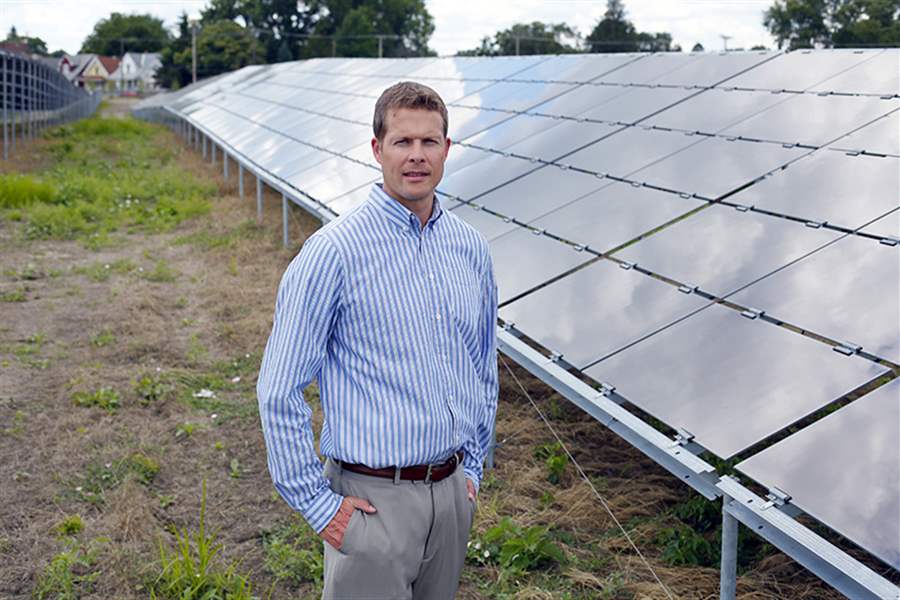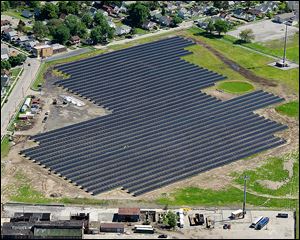
RUDOLPH/LIBBE PROJECT
Solar array to supply power to Toledo Zoo
Brownfield site will again be productive
7/22/2014
Jason Slatter, director of solar for Rudolph Libbe, stands in front of the companye's solar array project, one of the largest of its kind in this area, off of Spencer Road.
THE BLADE/AMY E. VOIGT
Buy This Image

Jason Slatter, director of solar for Rudolph Libbe, stands in front of the companye's solar array project, one of the largest of its kind in this area, off of Spencer Road.
A massive, 2.1-megawatt solar array that has put 22 acres of vacant South Toledo land back into production is to be dedicated today. It’s the kind of comeback that supporters believe will become less common across Ohio because of a recent bill Gov. John Kasich signed into law discouraging investments in renewable power.
The ceremony for the Rudolph/Libbe project near the Toledo Zoo is expected to draw a contingent of area business and government leaders interested in seeing how land contaminated by past industrial practices, known as brownfield sites, can go back on the tax rolls and generate clean energy while reducing blight.
In this case, a group of local investors led by Rudolph/Libbe Cos. — a limited liability company called Anthony Wayne Solar Number 1 — is doing that for one of the region’s largest employers and one of its most popular destinations, the Toledo Zoo.
The solar array and property, adjacent to the north side of the zoo’s main parking lot between Anthony Wayne Trail and Spencer Street, are owned by those investors, who have a long-term contract in place to sell electricity generated at the site exclusively to the zoo.
The project, developed by Rudolph/Libbe and a sister company, GEM Energy, will generate about 30 percent of the Toledo Zoo’s annual electricity needs, Jason Slattery, director of solar for Rudolph/Libbe Inc., said.

An aerial view of the Rudolph/Libbe solar array adjacent to the north side of the zoo’s main parking lot between Anthony Wayne Trail and Spencer Stree
“This project is a great example of the public and private sectors working together to benefit the zoo and the community,” Mr. Slattery said. “We took a contaminated brownfield site, a financial burden for the city, and turned it into a win for the city of Toledo and the Toledo Zoo.”
He and other supporters believe such projects will be harder to come by now, though, because of the two-year legislative freeze on renewable-energy mandates that Mr. Kasich has signed into law.
That legislation, known as Senate Bill 310, applies only to utilities, not companies such as Rudolph/Libbe. But Ohio became the nation’s first state with renewable-energy mandates to enact a two-year timeout.
A 2008 law requires utilities doing business in Ohio to steadily invest more in renewable power through 2025, when at least 12.5 percent of the electricity they provide is supposed to come from clean sources such as wind and solar energy.
Renewable energy advocates fear that two-year hiatus will put out a message to the business community that Ohio is no longer receptive to such investments.
Rudolph/Libbe, one of the region’s largest contractors, expects to be doing more work in Michigan and New York, which have strong incentives for solar projects, Mr. Slattery said.
The solar industry has had setbacks from the failure of a high-profile manufacturer, California-based Solyndra, as well as the deep financial troubles of local manufacturers such as Xunlight and Willard & Kelsey.
But Rudolph/Libbe’s an installer, not a manufacturer.
Growth in solar nationally has transformed the company’s business model.
Since 2008, Rudolph/Libbe went from virtually no involvement in solar to having 10 percent of its revenue come from it.
It believes solar-installation projects will eventually become the backbone of as much as 30 percent of Rudolph/Libbe’s revenue.
Although Rudolph/Libbe will likely have to rely on states other than Ohio for that sort of push, it still expects to line up some Ohio contracts during the two-year freeze and hopes state legislators regain their interest in what the company sees as a budding industry, Mr. Slattery said.
“We think the costs of doing solar is an unstoppable train and it’s not getting off the tracks,” he said.
Rudolph-Libbe’s costs for solar projects have come down from $9 per watt to $2 per watt since 2008. More affordable prices have resulted in more business, Mr. Slattery has said.
For the project near the zoo, investors worked with the Lucas County Land Bank, an agency that strives to repurpose vacant land, he said.
The site, formerly in receivership, was once home to a Haugh-ton Elevator Co. factory, but it has not been used since the early ’90s.
There are 28,500 solar panels on 15 of the site’s 22 acres. Additional panels could be put on some the remaining seven acres in the future. Officials first want to assess the viability of adding more, after examining the amount of shade cast off nearby homes along Spencer Street during the four seasons, Mr. Slattery said.
The site is believed to be one of the nation’s largest solar installations generating power for a zoo.
“This solar array supports the zoo’s mission by using cleaner and greener energy, reducing reliance on nonrenewable energy while providing an inspiring example for zoo visitors,” Jeff Sailer, Toledo Zoo executive director, said.
Rudolph/Libbe also developed the zoo’s 1,400-panel walkway, called SolarWalk, which was installed in 2010, as well as multiple other projects with the Ohio Air National Guard and ones with the city of Bryan and First Solar LLC of Perrysburg in recent years.
The zoo also has a wind turbine generating power for its main parking lot, and geothermal wells to heat and cool the aquarium.
Bill Rudolph, chairman of Rudolph/Libbe Cos., said the companies are “honored to support the Toledo Zoo’s mission of environmental stewardship through this project.”
The Ohio Department of Natural Resources has planted trees and shrubs near the fences to create a visual buffer and spruce up the aesthetics for area residents. Plans also call for native grasses to be planted across the site.
Union labor from northwest Ohio was used to build the project, which created about 60 temporary construction jobs.
Contact Tom Henry at: thenry@theblade.com or 419-724-6079.